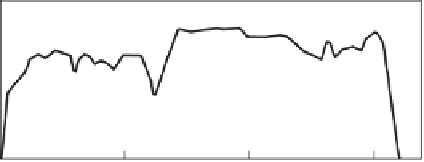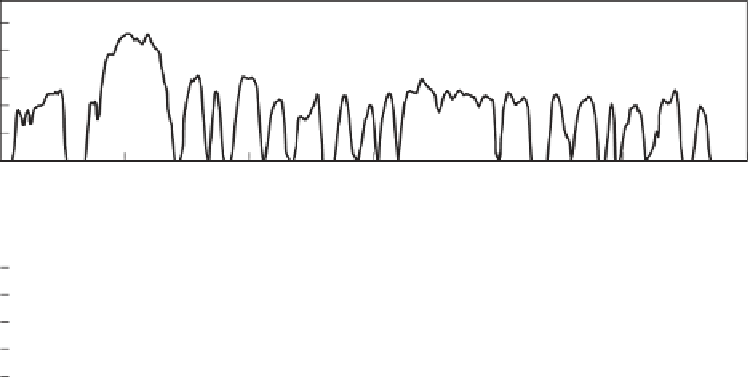Environmental Engineering Reference
In-Depth Information
100
80
60
40
20
0
0
4
8
12
16
20
24
Elapsed time (min)
100
80
60
40
20
0
0
4
8
12
Elapsed time (min)
Figure 8.7
U.S. EPA 1972 driving cycles for evaluating emissions and fuel economy. Upper curve: Urban
driving cycle (17.77-km length, 22.87-min duration, 31.4-km/h average speed, 91-km/h maximum speed,
1.48-m/s
2
maximum acceleration, cruise time 7.9 %, acceleration time 39.6 %, deceleration time 34.6 %, idle
time 17.8 %, 1.43 stops per kilometer). Lower curve: Highway driving cycle (16.5-km length, 12.7-min
duration, 78.5-km/h average speed, 96.4-km/h maximum speed, 1.43-m/s
2
maximum acceleration, cruise
time 16.5 %, acceleration time 44.4 %, deceleration time 38.7 %, idle time 0.4 %, 0.06 stops per kilometer).
(Data from Blackmore, D. R., and A. Thomas, 1977.
Fuel Economy of the Gasoline Engine.
London:
Macmillan.)
8.5.2
Improving Vehicle Fuel Economy
In the United States in 1993, a consortium of U.S. vehicle manufacturers and the U.S. federal
government undertook to develop a mid-size passenger vehicle that would attain a fuel economy
about three times the current value but would have performance properties equal to those of current
vehicles, yet would be affordably priced. Known as the Partnership for a New Generation of
Vehicles (PNVG), this ambitious program planned for introducing such a vehicle prototype by the
model year 2004. The fuel economy goal was judged to be attainable using current or developing
technologies. Even if the PNGV program fails to reach its ultimate goal of a highly fuel-efficient
vehicle, the technological improvements investigated will make it possible to greatly improve
vehicle fuel efficiency of current vehicles.
There are two major thrusts of the PNGV program: improvements to the vehicle design and to
the power source. Indeed, both vehicle and power source must be matched to obtain the maximum
benefit. Nevertheless, in what follows, we consider these separately, with the understanding that
they must not be considered in isolation.
8.5.2.1 Improving Vehicle Performance
In Section 8.4 we described the three components of power consumption in a moving vehicle:
vehicle acceleration, rolling resistance, and aerodynamic drag. The first two are proportional to


